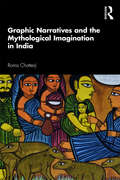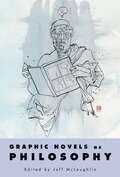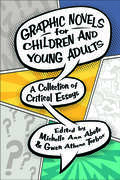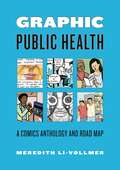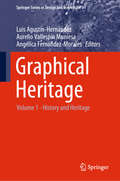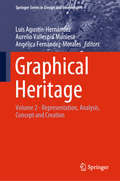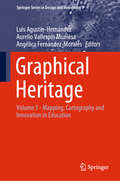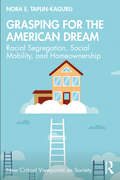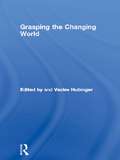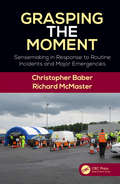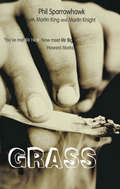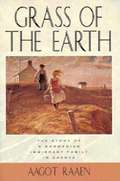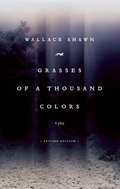- Table View
- List View
Graphic Migrations: Precarity and Gender in India and the Diaspora (Asian American History & Cultu #222)
by Kavita DaiyaIn Graphic Migrations, Kavita Daiya provides a literary and cultural archive of refugee stories and experiences to respond to the question “What is created?” after decolonization and the 1947 Partition of India. She explores how stories of Partition migrations shape and influence the political and cultural imagination of secularism and contribute to gendered citizenship for South Asians in India and its diasporas. Daiya analyzes modern literature, Bollywood films, Margaret Bourke-White’s photography, advertising, and print culture to show how they memorialize or erase refugee experiences. She also uses oral testimonies of Partition refugees from Hong Kong, South Asia, and North America to draw out the tensions of the nation-state, ethnic discrimination, and religious difference. Employing both Critical Refugee Studies and Feminist Postcolonial Studies frameworks, Daiya traces the cultural, affective, and political legacies of Partition migrations. The precarity generated by modern migration and expressed through public culture prompts a rethinking of how dominant media represents gendered migrants and refugees. Graphic Migrations demands that we redraw the boundaries of how we tell the story of modern world history and the intricately interwoven, intimate production of statelessness and citizenship across the world’s communities.
Graphic Narratives and the Mythological Imagination in India
by Roma ChatterjiThis book explores graphic narratives and comics in India and demonstrates how these forms serve as sites on which myths are enacted and recast. It uses the case studies of a comics version of the Mahabharata War, a folk artist’s rendition of a comic book story, and a commercial project to re-imagine two of India’s most famous epics – the Ramayana and the Mahabharata – as science fiction and superhero tales. It discusses comic books and self-published graphic novels; bardic performance aided with painted scrolls and commercial superhero comics; myths, folklore, and science fiction; and different pictorial styles and genres of graphic narration and storytelling. It also examines the actual process of the creation of comics besides discussions with artists on the tools and location of the comics medium as well as the method and impact of translation and crossover genres in such narratives. With its clear, lucid style and rich illustrations, the book will be useful to scholars and researchers of sociology, anthropology, visual culture and media, and South Asian studies, as well as those working on art history, religion, popular culture, graphic novels, art and design, folk culture, literature, and performing arts.
Graphic Narratives of Organised Crime, Gender and Power in Europe: Discarded Footnotes (Routledge Studies in Gender, Sexuality, and Comics)
by Felia Allum Anna MitchellThis book presents a unique series of graphic narratives which offer a new way to recount the lived experiences and life stories of women involved in transnational organised crime groups, from victims to perpetrators. Based on ethnographic interviews, and police files, academic Felia Allum and artist Anna Mitchell together seek to tell individual stories while also contributing to broader discourses about crime, power relations and victimhood. The four graphic stories cover cutting-edge issues in crime including County lines and British gangs, Nigerian syndicates, Italian Mafias, and Albanian drug gangs, and all stories effectively and forcefully depict the voices of those who are often voiceless and hidden in a more complex social and criminal phenomenon. This book is suitable for students and scholars in criminology, sociology, gender studies and comics studies, as well as for the general reader.
Graphic Novels as Philosophy
by Jeff McLaughlinContributions by Eric Bain-Selbo, Jeremy Barris, Maria Botero, Manuel “Mandel” Cabrera Jr., David J. Leichter, Ian MacRae, Jeff McLaughlin, Alfonso Muñoz-Corcuera, Corry Shores, and Jarkko TuusvuoriIn a follow-up to Comics as Philosophy, international contributors address two questions: Which philosophical insights, concepts, and tools can shed light on the graphic novel? And how can the graphic novel cast light on the concerns of philosophy? Each contributor ponders a well-known graphic novel to illuminate ways in which philosophy can untangle particular combinations of image and written word for deeper understanding.Jeff McLaughlin collects a range of essays to examine notable graphic novels within the framework posited by these two questions. One essay discusses how a philosopher discovered that the panels in Jeff Lemire’s Essex County do not just replicate a philosophical argument, but they actually give evidence to an argument that could not have existed otherwise. Another essay reveals how Chris Ware’s manipulation of the medium demonstrates an important sense of time and experience. Still another describes why Maus tends to be more profound than later works that address the Holocaust because of, not in spite of, the fact that the characters are cartoon animals rather than human.Other works contemplated include Will Eisner’s A Contract with God, Alan Moore and David Lloyd’s V for Vendetta, Alison Bechdel’s Fun Home, and Joe Sacco’s Footnotes in Gaza. Mainly, each essay, contributor, graphic novelist, and artist is doing the same thing: trying to tell us how the world is—at least from their point of view.
Graphic Novels for Children and Young Adults: A Collection of Critical Essays (Children's Literature Association Series)
by Michelle Ann Abate & Gwen Athene TarboxWith contributions by Eti Berland, Rebecca A. Brown, Christiane Buuck, Joanna C. Davis-McElligatt, Rachel Dean-Ruzicka, Karly Marie Grice, Mary Beth Hines, Krystal Howard, Aaron Kashtan, Michael L. Kersulov, Catherine Kyle, David E. Low, Anuja Madan, Meghann Meeusen, Rachel L. Rickard Rebellino, Rebecca Rupert, Cathy Ryan, Joe Sutliff Sanders, Joseph Michael Sommers, Marni Stanley, Gwen Athene Tarbox, Sarah Thaller, Annette Wannamaker, and Lance WeldyOne of the most significant transformations in literature for children and young adults during the last twenty years has been the resurgence of comics. Educators and librarians extol the benefits of comics reading, and increasingly, children's and YA comics and comics hybrids have won major prizes, including the Printz Award and the National Book Award. Despite the popularity and influence of children's and YA graphic novels, the genre has not received adequate scholarly attention.Graphic Novels for Children and Young Adults is the first book to offer a critical examination of children's and YA comics. The anthology is divided into five sections, structure and narration; transmedia; pedagogy; gender and sexuality; and identity, that reflect crucial issues and recurring topics in comics scholarship during the twenty-first century. The contributors are likewise drawn from a diverse array of disciplines--English, education, library science, and fine arts. Collectively, they analyze a variety of contemporary comics, including such highly popular series as Diary of a Wimpy Kid and Lumberjanes; Eisner award-winning graphic novels by Gene Luen Yang, Nate Powell, Mariko Tamaki, and Jillian Tamaki; as well as volumes frequently challenged for use in secondary classrooms, such as Raina Telgemeier's Drama and Sherman Alexie's The Absolutely True Diary of a Part-Time Indian.
Graphic Public Health: A Comics Anthology and Road Map (Graphic Medicine)
by Meredith Li-VollmerAs we confront the challenges of emerging diseases, environmental health threats, and gaps in health equity, medical professionals need versatile communication tools that help people make informed decisions and engage them in constructive conversations about the health of their communities. This book illuminates the power of comics to meet that need.Graphic Public Health demonstrates the range and potential of comics to address topics such as immunization promotion, outbreak prevention, gun violence, opioid addiction prevention, and climate change. It features the work of acclaimed cartoonists Ellen Forney, David Lasky, and Roberta Gregory, pieces by up-and-coming artists, and comics that Meredith Li-Vollmer produced as a communications specialist for Seattle’s public health department. More than a collection of cartoons, this book connects comics with fundamentals of health communication and discusses why the form can be uniquely effective for these purposes. Each chapter focuses on the use of graphic public health in the context of four specific goals: health literacy, risk communication, health promotion, and advocacy. Li-Vollmer also includes guidance for practitioners getting started in creating comics for any form of public information, and especially for public health.Practical and purposeful, Graphic Public Health is a clarion call for the current era and an invaluable resource for public health professionals and advocates, scholars of comics and graphic studies, and fans of the graphic medicine genre.
Graphical Heritage: Volume 1 - History and Heritage (Springer Series in Design and Innovation #5)
by Luis Agustín-Hernández Aurelio Vallespín Muniesa Angélica Fernández-MoralesThis book presents the proceedings of the 18th International Conference on Graphic Design in Architecture, EGA 2020, focusing on heritage – including architectural and graphic heritage as well as the graphics of heritage. This first volume gathers selected contributions covering theories, and new technologies and findings to help shed light on current questions related to heritage. It features original documentation studies on historical archives, 3D and solid representation of architectural objects, as well as virtual graphic representation and applications of augmented reality, all documenting and/or reconstructing the present, past and future of architectural objects. As such, this book offers extensive and timely information to architectural and graphic designers, urban designers and engineers, and industrial designers and historians.
Graphical Heritage: Volume 2 - Representation, Analysis, Concept and Creation (Springer Series in Design and Innovation #6)
by Luis Agustín-Hernández Aurelio Vallespín Muniesa Angélica Fernández-MoralesThis book presents the proceedings of the 18th International Conference on Graphic Design in Architecture, EGA 2020, focusing on heritage – including architectural and graphic heritage as well as the graphics of heritage. Consisting of two parts: “Representation and Analysis” and “Concept and Creation”, this second volume gathers selected contributions on topics ranging from graphic representation to the graphic presentation of ideas, i.e. artistic creation, to bridge the gap between graphic heritage and the graphics of heritage. Given its scope, this volume will appeal to architectural and graphic designers, artists and engineers, providing them with extensive information on new methods and a source of inspiration for future research and interdisciplinary collaborations.
Graphical Heritage: Volume 3 - Mapping, Cartography and Innovation in Education (Springer Series in Design and Innovation #7)
by Luis Agustín-Hernández Aurelio Vallespín Muniesa Angélica Fernández-MoralesThis book presents the proceedings of the 18th International Conference on Graphic Design in Architecture, EGA 2020, focusing on heritage – including architectural and graphic heritage as well as the graphics of heritage. The third of three volumes, this book discusses topics related to mapping, cartography and landscape, as well as innovative education methods, particularly in the context of teaching architectural heritage. It covers historical cartography and new cartographies, as well as methods for representing the landscape, and reports on different learning methods and practices, including classroom methods but also those involving more active participation and multidisciplinary and collaborative production. Given its scope, this book will appeal cartographers, designers and teachers, providing them with extensive information on innovative methodologies and a source of inspiration for their future work.
Grasping for the American Dream: Racial Segregation, Social Mobility, and Homeownership
by Nora E. Taplin-KaguruAfrican American homebuyers continue to pay more for and get less from homeownership. This book explains the motivations for pursuing homeownership amongst working-class African Americans despite the structural conditions that make it less economically and socially rewarding for this group. Fervent adherence to the American Dream ideology amongst working-class African Americans makes them more vulnerable to exploitation in a structurally racist housing market. The book draws on qualitative interviews with sixty-eight African American aspiring homebuyers looking to buy a home in the Chicago metropolitan area to investigate the housing-search process and residential relocation decisions in the context of a racially segregated metropolitan region. Working-class African Americans remained committed to homeownership, in part because of the moral status attached to achieving this goal. For African American homebuyers, success at the American Dream of homeownership is directly related to the long-standing dream of equality. For the aspiring homebuyers in this study, delayed homeownership was a practical problem for the same reasons, but they also experienced this as a personal failing, due to the strong cultural expectation in the United States that homeownership is a milestone that middle-class adults must achieve. Furthermore, despite using perfectly reasonable housing search strategies to locate homes in stable or improving racially integrated neighborhoods, the structure of racial segregation limits their agency in housing choices. Ultimately, policy solutions will need to address structural racism broadly and be attuned to the needs of both homeowners and renters.
Grasping the Changing World (European Association of Social Anthropologists)
by Václav HubingerAs different societies merge into one global society and face the concomitant crisis of identity, of purpose and interest, social anthropology urgently needs to bring its methodology up to date: new methods are needed to analyse, compare and understand different cultures across space and time.Grasping the Changing World collects papers read at the second biannual EASA conference in Prague in 1992. The conference took place in an extraordinary 'postmodern' setting. With the fall of communist regimes in Central and Eastern Europe old certainties and time-honoured concepts had become obsolete; at the same time, anthropology too was in upheaval, and long-established patterns of thought seemed inadequate to grasp the rapidly changing realities. These doubts and tensions are reflected in this collection.The first half of Grasping the Changing World focuses on ways of conceptualising, modelling and perceiving the present, while the second half reassesses the theoretical strength or otherwise of social anthropology as a modern science. Combining methodological rigour and originality, this collection will make invaluable reading for all students of social anthropology, sociology and politics and its methodology as it is applied to the comparison and understanding of societies across space and time.
Grasping the Moment: Sensemaking in Response to Routine Incidents and Major Emergencies
by Christopher Baber Richard McMasterThe ways in which organizations make use of information available to them to make decisions and manage activity is an essential topic of investigation for human factors. When the information is uncertain, incomplete or subject to change, then decision making and activity management can become challenging. Under such circumstances, it has become commonplace to use the concept of sensemaking as the lens through which to view organizational behavior. This book offers a unique perspective on sensemaking through its consideration of the variety of ways in which Incident Response is managed by the Police. As an incident moves from the initial call handling to subsequent mobilization of response to first officer attending, a wide range of information is acquired, processed and shared, and the organization (and individuals who work within it) face challenges of making sense of the situation to which they are responding. Moving from routine incidents to large-scale emergencies, the authors explore how sensemaking is influenced and affected by the challenges of interoperability within and between organizations. In addition, the book develops a view of sensemaking which draws on the theory of distributed cognition, focusing in particular on the question of how the technology that is available to Police personnel can support (and sometimes thwart) their ability to make sense of the unfolding situation. The main argument in this book is that sensemaking is distributed cognition, and that cognitive processes involved in sensemaking are mediated through interactions with artifacts and other agents. Three perspectives of sensemaking as distributed cognition are presented: making sense with artifacts, making sense through artifacts, and making sense through collaboration.
Grasping the World: The Idea of the Museum (Routledge Revivals)
by Donald Preziosi Claire FaragoFirst published in 2004, this volume recognises that there is much more to museums than the documenting, monumentalizing, or theme-parking of identity, history and heritage. This landmark anthology aims to make strange the very existence of museums and to plot a critical, historical and ethical understanding of their origins and history. A radical selection of key texts introduces the reader to the intense investigation of the modern European idea of the museum that has taken place over the last fifty years. Texts first published in journals and books are brought together in one volume with up-to-the-minute and specially commissioned pieces by leading administrators, curators and art historians. The selections are organized by key themes that map the evolution of the debate and introduced by Donald Preziosi and Claire Farago, two considerable critics, who write with the edge and enthusiasm of art historians who have spent their lives working with museums. Grasping the World is an invaluable resource for students and teachers of art history and museum studies.
Grass
by Martin Knight Martin King Phil SparrowhawkGrass is the incredible story of Phil Sparrowhawk, a working-class boy with gambling in his blood. Like most punters, he enjoyed an incredible run of luck, but finally rolled the dice once too often.Before he had come of age, Phil had accumulated a small fortune from street trading. He then staked his entire capital on Njinsky in the 1970 Derby - and won. With his now large capital base, he launched a business importing clothes. Enter Howard Marks (aka Mr Nice), who was enthused by Phil's Far East connections and introduced him to the far more lucrative world of the 'movement of beneficial herbs' - or drug smuggling, as it is known to the authorities. Phil struck out on his own and from his new base in Thailand became involved in many large-scale cannabis deals, whilst at the same time developing highly successful legitimate businesses. Read of his encounters with Greenpeace, Mother Teresa, gangsters and leading politicians, Lord Moynihan, religious cults, former pop singers and many other diverse characters as his life became more and more surreal. The winning streak came to an end in 1988 when the US Drug Enforcement Agency closed in. Phil's £30m fortune was promptly confiscated and he spent the next four years in two of Thailand's most notorious jails before being extradited to the US, where he served further time in a series of penitentiaries. Grass details the life of an ordinary young man with a taste for adventure, who ended up on the most extraordinary journey. Sit back, take a deep breath and enjoy.
Grass of the Earth: Immigrant Life in the Dakota Country
by Aagot RaaenThis is an engaging, richly detailed biography of a family of Norwegian immigrant homesteaders in eastern North Dakota in the late 1800s.
Grasses of a Thousand Colors
by Wallace ShawnAn updated and revised edition of Wallace Shawn's most outlandish work to date.This poetic epic about a scientist, his wife, and his two mistresses as they fend for their lives in a world savagely close to extinction, raises issues of redemption, forgiveness, and responsibility. Grasses of a Thousand Colors is a troubling, erotic adventure that received high critical praise for its first New York City revival in 2013, starring Shawn.Wallace Shawn is a noted actor and writer. His often politically charged and controversial plays include The Fever, Aunt Dan and Lemon, Marie and Bruce, and The Designated Mourner.
Grasses of a Thousand Colors
by Wallace Shawn"Among living American writers for the theater today, Wallace Shawn is among the most respected by his peers and championed by serious critics."--Don Shewey"The play is bound to delve further into the world that Shawn began to explore so precipitously nearly thirty-five years ago: one filled with ideas, wherein the action is the domestication of cruelty."--The New YorkerGrasses of a Thousand Colors is a poetic epic that tells the story of a scientist (Ben), his wife (Cerise), and his two mistresses (Robin and Rose), as they fend for their lives in a world much like ours, yet one savagely close to extinction. Due to the scientific manipulation of the world's crops, a destructive system for which Ben is partly responsible, there is very little nourishment left to be had, except for those most privileged and connected. Despite the dying off of most of the world, these characters manage to survive, at times tasting the good life, admiring the beauties of nature, feasting on animalistic sex, and finding love. The play raises issues of redemption, forgiveness, and responsibility as it recounts a somewhat passionate, erotic adventure story.Wallace Shawn is the author of Our Late Night (winner of the OBIE Award for Best Play), Marie and Bruce, Aunt Dan and Lemon, The Designated Mourner, The Fever, and the screenplay for My Dinner with Andre, in which he starred. Grasses of a Thousand Colors, Shawn's first full-length play in ten years, will be produced in the United Kingdom and the United States in 2009. Shawn is a well-known film and television actor. He resides in New York City.
Grasslands Grown: Creating Place on the U.S. Northern Plains and Canadian Prairies
by Molly P. RozumIn Grasslands Grown Molly P. Rozum explores the two related concepts of regional identity and sense of place by examining a single North American ecological region: the U.S. Great Plains and the Canadian Prairie Provinces. All or parts of modern-day Alberta, Montana, Saskatchewan, North Dakota, South Dakota, and Manitoba form the center of this transnational region. As children, the first postconquest generation of northern grasslands residents worked, played, and traveled with domestic and wild animals, which introduced them to ecology and shaped sense-of-place rhythms. As adults, members of this generation of settler society worked to adapt to the northern grasslands by practicing both agricultural diversification and environmental conservation. Rozum argues that environmental awareness, including its ecological and cultural aspects, is key to forming a sense of place and a regional identity. The two concepts overlap and reinforce each other: place is more local, ecological, and emotional-sensual, and region is more ideational, national, and geographic in tone. This captivating study examines the growth of place and regional identities as they took shape within generations and over the life cycle.
Grassroots Asian Theology: Thinking the Faith from the Ground Up
by Simon ChanGrassroots Asian Theology,Grassroots Asian Theology
Grassroots Charisma: Four Local Leaders in China (Routledge Studies on China in Transition #Vol. 10)
by Stephan Feuchtwang Wang MingmingThis book relates the stories of four leaders under very different political regimes: Colonial, Nationalist and Communist. The authors compare Chinese notions of respect and inspiration with their equivalents in other religious and political histories of colonial and post-colonial modernity, thereby producing a thorough re-working of the idea of charisma. The result is an intriguing study of the relationship between religious and political authority in a changing world.
Grassroots Development Initiatives in India: Rights Based Approach to Development and Advocacy
by Sampat KaleThis book examines how the voluntary organisations engaged with development programmes work with the approach of conscientisation to empower Adivasis. Their work has been instrumental in making government machinery pro-poor by implementing development programmes with greater transparency and accountability. Conscientisation of Adivasis by voluntary organisations through their educative role has resulted in the advancement of their lives and the emergence of autonomous leadership. The study concludes that the ideological base of the founders of the organisations made the Adivasis independent and self-supportive for their development from their earlier status of servitude through initiating and accomplishing the task of conscientisation. This title is co-published with Aakar Books. Print editions not for sale in South Asia (India, Sri Lanka, Nepal, Bangladesh, Pakistan and Bhutan)
Grassroots Environmental Action: People's Participation in Sustainable Development
by Dharam Ghai Jessica M. VivianManaging resources sustainably on the local level is essential for achieving the global goal of sustainable development. The importance of people's participation for sustainable development has recently become increasingly acknowledged yet there is little understanding of the multiple dimensions that such participation involves. Grassroots Environmental Action questions the viability of traditional management systems. Case studies from Latin America, Asia and Africa focus on areas where local people are vigorous actors in the determination of their own future and that of their environment.
Grassroots Fascism: The War Experience of the Japanese People
by Ethan Mark Yoshimi YoshiakiGrassroots Fascism profiles the Asia Pacific War (1941--1945) -- the most important though least understood experience of Japan's modern history -- through the lens of ordinary Japanese life. Moving deftly from the struggles of the home front to the occupied territories to the ravages of the front line, the book offers rare insight into popular experience from the war's troubled beginnings through Japan's disastrous defeat in 1945 and the new beginning it heralded.Yoshimi Yoshiaki mobilizes personal diaries, memoirs, and government documents to portray the ambivalent position of ordinary Japanese as both wartime victims and active participants. He also provides equally penetrating accounts of the war experience of Japan's imperial subjects, including Koreans and Taiwanese. This book challenges the idea that the Japanese operated as a passive, homogenous mass during the war -- a mere conduit for a military--imperial ideology imposed upon them by the political elite. Viewed from the bottom up, wartime Japan unfolds as a complex modern mass society, with a corresponding variety of popular roles and agendas. In chronicling the diversity of the Japanese social experience, Yoshimi's account elevates our understanding of Japan's war and "Japanese Fascism," and in its relation of World War II to the evolution -- and destruction -- of empire, it makes a fresh contribution to the global history of the war. Ethan Mark's translation supplements the Japanese original with explanatory annotations and an in-depth analytical introduction, drawing on personal interviews to situate the work within Japanese studies and global history.
Grassroots Fascism: The War Experience of the Japanese People (Weatherhead Books on Asia)
by Yoshiaki YoshimiGrassroots Fascism profiles the Asia Pacific War (1937–1945)—the most important though least understood experience of Japan's modern history—through the lens of ordinary Japanese life. Moving deftly from the struggles of the home front to the occupied territories to the ravages of the front line, the book offers rare insights into popular experiences from the war's troubled beginnings through Japan's disastrous defeat in 1945 and the new beginning it heralded.Yoshimi Yoshiaki mobilizes diaries, letters, memoirs, and government documents to portray the ambivalent position of ordinary Japanese as both wartime victims and active participants. He also provides penetrating accounts of the war experiences of Japan's minorities and imperial subjects, including Koreans and Taiwanese. His book challenges the idea that the Japanese people operated as a mere conduit for the military during the war, passively accepting an imperial ideology imposed upon them by the political elite. Viewed from the bottom up, wartime Japan unfolds as a complex modern mass society, with a corresponding variety of popular roles and agendas.In chronicling the diversity of wartime Japanese social experience, Yoshimi's account elevates our understanding of "Japanese Fascism." In its relation of World War II to the evolution—and destruction—of empire, it makes a fresh contribution to the global history of the war. Ethan Mark's translation supplements the Japanese original with explanatory notes and an in-depth introduction that situates the work within Japanese studies and global history.
Grassroots Garveyism
by Mary G. RolinsonThe black separatist movement led by Marcus Garvey has long been viewed as a phenomenon of African American organization in the urban North. But as Mary Rolinson demonstrates, the largest number of Universal Negro Improvement Association (UNIA) divisions and Garvey's most devoted and loyal followers were found in the southern Black Belt. Tracing the path of organizers from northern cities to Virginia, and then from the Upper to the Deep South, Rolinson remaps the movement to include this vital but overlooked region.Rolinson shows how Garvey's southern constituency sprang from cities, countryside churches, and sharecropper cabins. Southern Garveyites adopted pertinent elements of the movement's ideology and developed strategies for community self-defense and self-determination. These southern African Americans maintained a spiritual attachment to their African identities and developed a fiercely racial nationalism, building on the rhetoric and experiences of black organizers from the nineteenth-century South. Garveyism provided a common bond during the upheaval of the Great Migration, Rolinson contends, and even after the UNIA had all but disappeared in the South in the 1930s, the movement's tenets of race organization, unity, and pride continued to flourish in other forms of black protest for generations.

